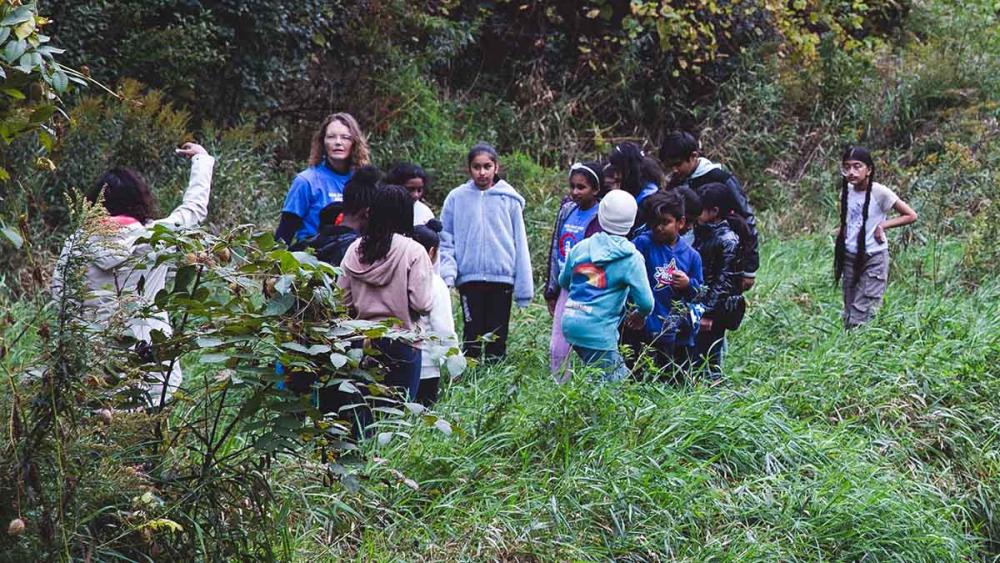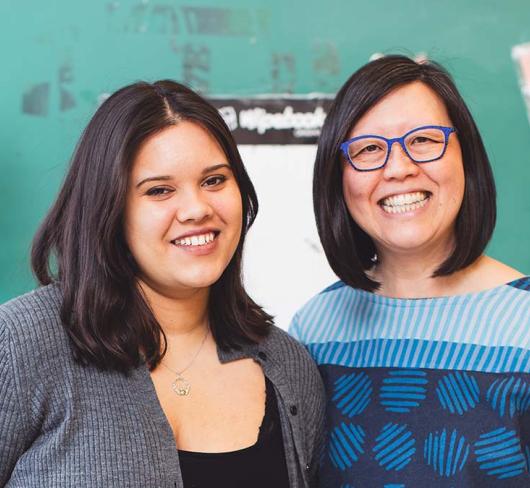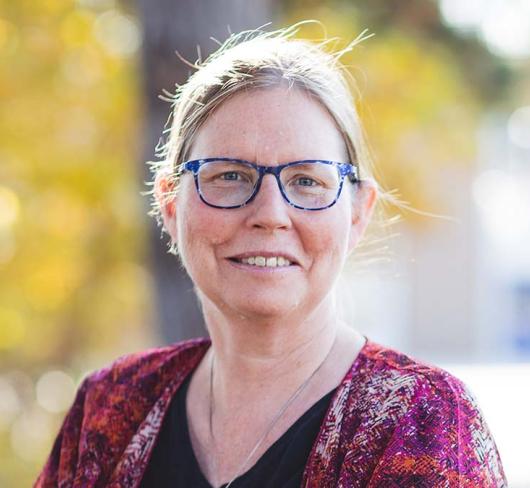
It's All About Relationships
White whisps of breath from the hundreds of students streaming out of Cherrytree Public School twirled up into the bright blue sky. It was March 22, 2022, World Water Day, and class by class, the Brampton students filed down to a local creek a few blocks away. Clutched in their mittens were handwritten songs containing their words and feelings for the water. The students were excitedly chatting away. They had never taken a walk to the creek with the music and phys. ed teachers; it was a first for us as educators as well.
As we walked, I grew uneasy. How would students react to singing to the water? Would they feel weird or silly for singing to a creek? Would they feel a deep connection, or would they even connect at all?
That morning, students had a range of reactions. I saw some connect, closing their eyes for a moment or singing along to the powerful words of the Nibi Water Song with their whole selves. A small group of students at the back joked around, and others observed and listened, quietly taking in the beauty of our urban outdoor setting.
At the end of the short 15-minute walk and waterside song sharing, I felt a new spark of joy – I had found a tangible way of connecting my music curriculum to the land and Indigenous ways of knowing. That morning was the beginning of students and staff building a relationship with the urban landscape, specifically the water, our relative, around our school.
I am a Water Walker for the Credit River and a settler-Anishinaabe educator living and teaching on the traditional territory of the Mississaugas of the Credit First Nation. For many years, I have brought Indigenous music, books and ways of knowing and doing into my music program. But my Songs for the Water program, which has grown organically since that first walk, is making the biggest impact – for my students, the Earth and myself as a lifelong learner and reflective practitioner.
Over the past few years, I’ve expanded the reach of Songs for the Water to a board and community level, including a trip to Island Lake Conservation Area at the headwaters of the Credit River. Through these experiences, my students have begun to see themselves as stewards of the water while gaining a sense of agency.
Water is Our Relative: Learning From the Grandmothers
My water program is deeply influenced by Josephine Mandamin-baa, the first Grandmother Water Walker. In 2022, I began sharing her vision and Indigenous views of water by teaching about the Grandmother Water Walkers and their movement to heal the waters around the Great Lakes and the rivers in between. In recent years, I was also introduced to Masaru Emoto’s water consciousness research. A pioneer in the study of water, he observed that water exposed to positive stimuli formed beautiful, symmetrical crystals, while water subjected to negative influences showed distorted, chaotic patterns.
In traditional curriculum, our students are taught about water as a resource. In my program, students hear and see First Nations, Inuit and Métis people singing to water, praying for water and telling stories connected to this practice. They learn from inspirational water activists and Knowledge Keepers and discover that water is our relative and needs to be cared for just like humans need care. I share the Nibi Water Song, written by Doreen Day and her grandson and sung by Indigenous and non-Indigenous people across Turtle Island. This song says: “Water we love you, we thank you, we respect you.”
I ground my teaching in literature and authentic voices, sharing books and videos made by First Nations, Inuit and Métis peoples as much as possible. Every year, I choose a book by an Indigenous author about water along with a video highlighting different Indigenous worldviews of water to share with my students.
Writing Songs for the Water
In 2022, after sharing these teachings and stories, I asked my students in grades 1 to 5 to write their own songs for the water. When sharing Indigenous teachings and culture, it’s crucial that students do not copy or appropriate materials, but instead reflect on them and use them as inspiration for their own creations. I teach in Brampton, a community where many families are first- or second- generation immigrants who speak more than one language at home and have their own rich culture to draw from. I encouraged students to share their own messages in the language they chose. Working closely with the ESL educator in my school, I have learned the importance of “translanguaging,” so I try as much as possible to find openings for students’ home languages.
I encouraged students to write songs from the heart, with no rules about time signatures, rhyming words or notating rhythms and pitch. I encouraged them to write and sing from their heart with no barriers. As the students worked on their songs, an incredible and unexpected thing happened: They made connections to practices of honouring and caring for the water from their own cultures. Students talked to their families about their songs, and their grandmothers and aunties shared their own practices around water.
Building Relationships to Grow World Water Day
Strong relationships with my administration, classroom and support teachers have been key to whole-school success. At Cherrytree, I am grateful to the administrators who have trusted my vision, classroom teachers who have shifted their planning time around World Water Day and our outdoor adventure days.
I’m especially grateful to my teaching partner, Staci Dhillon, the physical education teacher who opened up her programming to include Land-based learning. My daily schedule wouldn’t allow all students to sing and visit the water in one day, however our strong partnership allowed Staci and me to buddy up our classes so that all 13 of our grade 1 to 5 classes were able to sing to the water on World Water Day.
The Songs for the Water activity that we began on World Water Day in 2022 has led to monthly Land-based learning for all students in grades 1 to 5. Staci and I plan these days to help students get to know our plant and animal relatives and create more connections to the water.
One activity we continue to build on is plant journals. On our walks, students choose one tree or plant, identify it and then learn about it independently. They make a sketch and present it to the class. The aim is for us to collectively name our plant relatives. In doing this, we build deeper connections and respect for each plant and its role on Earth, becoming natural stewards of the Land and defending our plant families from harm, just as we would our own human families.
Decolonizing Music Teaching
In 2024, I brought teachings about water and water awareness to two school board arts events – the dance showcase and the music showcase. My goal was to embed Indigenous ways of knowing into events that traditionally centred western music.
Bringing Indigenous ways of knowing and being into all aspects of education is about more than reading an Indigenous picture book or listening to an Indigenous artist.
At the music showcase, approximately 12 ensembles consisting of 400 students from across Peel sing a song as the finale to the evening. As the director of the Indigenous drum ensemble, I suggested to my fellow directors that we choose the Nibi Water Song for the finale to highlight the importance of honouring and protecting the water. The directors liked the idea, so I created a video of myself singing the song for the directors to share with students, as well as links to videos of Indigenous people sharing teachings. There is no sheet music for the Nibi Water Song, no chord progressions or time signatures. This is the same for all the Indigenous drum songs I know.
Within a day or two of sharing the song, I received questions from directors about starting notes and time signatures. One director sent me a notated version of the Nibi song she created from my recording. While I knew where she was coming from, I shared with my colleagues that traditionally, our songs are not notated and we do not choose a starting note. Instead, whoever is leading the song just starts singing and the rest of us match the note. The next lead singer may start on a different note and the chorus just follows along. This was a great opportunity to show where our western education leads us to “colonize” Indigenous knowledge, in a way that we aren’t even aware of. I am so grateful to my music colleagues who trusted the idea and helped their ensembles learn the song.
The students from my Indigenous Music Ensemble led the Nibi song as we closed the show. It was a powerful moment seeing six Indigenous students surrounded and backed by 400 voices, not only honouring the water, but honouring Indigenous ways of knowing and being.
For the dance showcase at the Living Arts Centre in Mississauga, our school was one of 20 Peel schools chosen to share a four-minute dance piece connected to a social justice issue. Staci and I helped students choreograph a dance called “For Water.”
Wearing T-shirts from the Credit River Water Walk, students incorporated flowing water movements into their dance, sharing that they are the voice of animals and plants and that water is our first medicine. They shared the same dance at a joint event with Water Walkers in May 2024. This was the beginning of the next step in growing my water teaching program, which is to weave in cultural reciprocity, a key component when sharing any Indigenous teaching in non-Indigenous communities.
Cultural Reciprocity
In May 2024, all grade 3 to 5 students in my school were invited to the headwaters of the Credit River for Songs for the Water, a daylong event of listening, learning and sharing with Grandmothers and other Water Walkers, hosted by the Island Lake Conservation Area. Three busloads of excited students arrived at the headwaters to learn and to reciprocate by sharing their own dances and songs for the water. This was truly inspiring, not only for the students and staff, but also for the Water Walkers who were deeply touched by the sentiments of these settler students.
The Ripple Effect
I believe that what happens on a small scale will be reflected in a larger way in the world. As my water teachings and my own experience grew, I created new relationships with the community, my students and colleagues. As we learn to see ourselves as stewards of the Earth, we also learn how it is our responsibility to protect nature.
This September, as we headed into our fourth year of singing to the water, students started asking me, “When do we get to go sing to the water?” I told them, we will wait until World Water Day in March, but that they can sing to water anytime.
As educators, we are preparing our future leaders and policy makers – and we must prepare them all to be stewards of the Land. This water program is one way of showing students that they have agency and that it’s up to each of us to take action.
Jennifer Luxmore-Begin is a member of the Peel Teacher Local.

